Top Tier CPU Air Coolers Q3 2015: 9-Way Roundup Review
by E. Fylladitakis on July 6, 2015 8:00 AM ESTThe SilentiumPC Grandis XE1236
SilentiumPC is a Polish company that is fairly well known in Europe, yet with virtually no presence in the North American markets. The company was founded in 2007, aiming to provide a wide variety of cooling and case solutions at competitive prices. For the means of this review, SilentiumPC provided us with the Grandis XE1236, which currently is the best cooler the company produces.
The Grandis is supplied in an aesthetically plain but effective cardboard box. There is nothing of note regarding the appearance of the packaging, as the only artwork is a picture of the cooler itself. It does offer good shipping protection though, with the cooler protected inside a clear plastic shell and the bundled items grouped in secondary cardboard boxes.
With the company focused on minimizing the costs, we did not expect the bundle of the Grandis to be grand. Nevertheless, besides the necessary mounting hardware and wire clips for three fans, SilentiumPC provides a tube of quality Pactum PT-1 thermal compound and a Y 4-pin fan power splitter. A small wrench tool is also provided, necessary for the installation of the cooler.
The Grandis is supplied with two 120 mm cooling fans. Both fans are mechanically and electrically identical, with black solid frames and tinted black blades. They have been rebranded and it is difficult to recognize their OEM. Their electrical specifications, speed and sleeving type match the Power Logic PL12S12L, yet the acoustic ratings are worlds apart.
The Grandis XE1236 is a symmetric dual tower CPU cooler, with relatively narrow towers for its class. The fins of both towers are perfectly symmetric as well, meaning that both their front and rear sides are identical, mostly straight with shallow indentations near their center. SilentiumPC died the top fin black, obviously for aesthetic purposes only, but it does not cover the copper heatpipes.
Up to three 120 mm cooling fans can be installed on the Grandis, using the provided wire clips. The wire clips are strangely shaped and very wide, expanding above and below the cooling fans. This makes them flimsy and prevents the movement of the front fan upwards to offer clearance for the RAM modules, if necessary. The center fan will have to be removed for the installation of the cooler, as there are no holes for a screwdriver. Do note that a Philips PH2 screwdriver with a shank longer than 145 mm is necessary for the installation of the Grandis, which is not supplied.
The base of the Grandis XE1236 is about as simple as the rest of the cooler is. It is split into two parts: the narrow lower copper part serves as the contact surface and the aluminum/steel top part provides mechanical cohesion and retention. Six 6 mm copper heatpipes expand from the base of the cooler to either tower on both sides, evenly spaced at the right and the left half of each tower. In order to keep the costs down, SilentiumPC did not plate the copper parts of the Grandis. The quality of the contact surface is disappointing, not because it has not been polished at all but because there are multiple machining marks visible with the naked eye and easily feelable by touch.


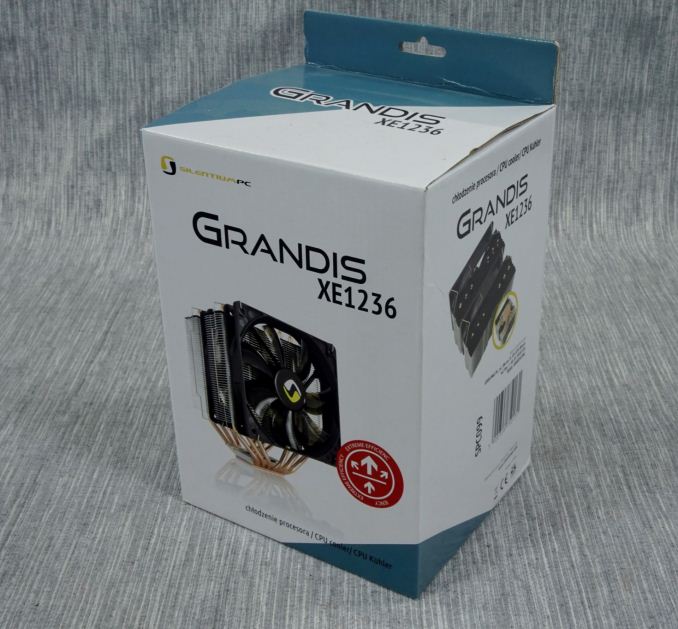
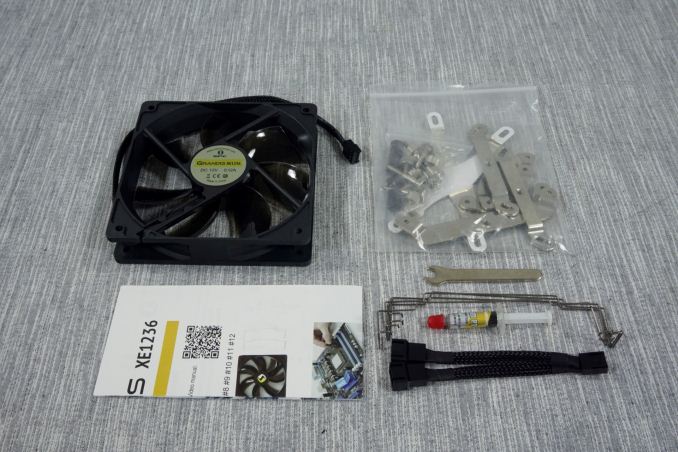
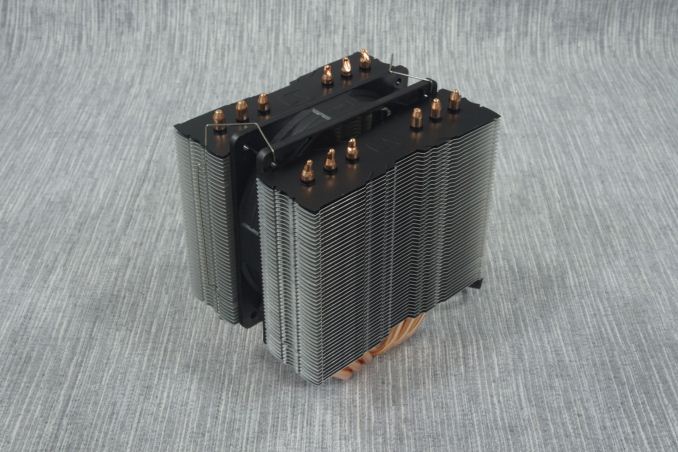
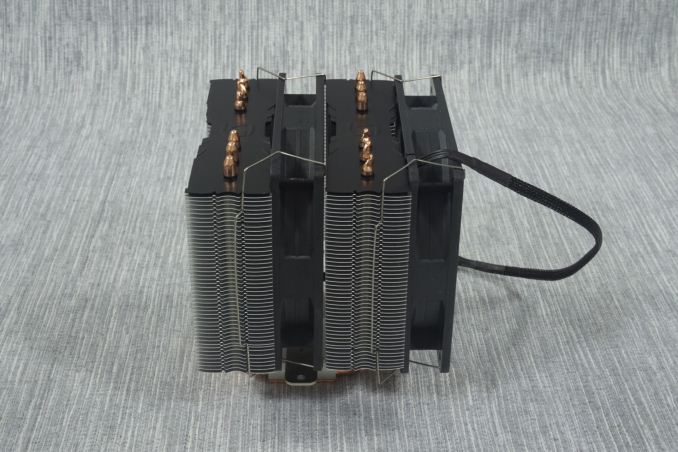
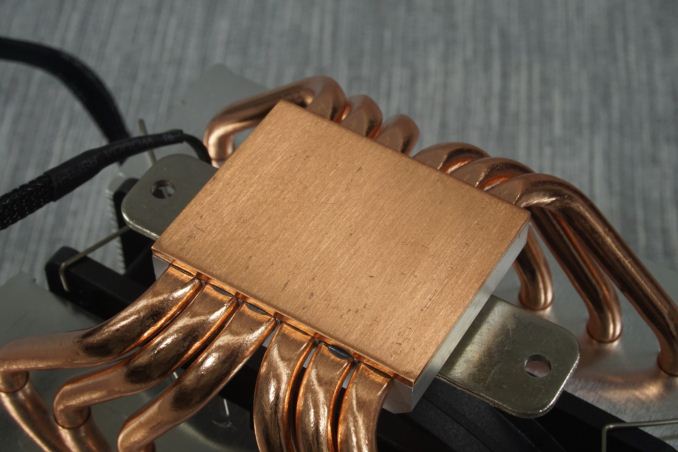








135 Comments
View All Comments
marraco - Monday, July 6, 2015 - link
Something really important that never is reviewed is dust control and maintenance.As radiator fins get closer, they have more dissipation area, but air flow gets worse. Yet the main problem of fins closeness is that they accumulate dust much faster, and get occluded.
No review makes a dust test. I have a Thermaltake cooler, which works excellent when is clean, but it rapidly loses his capacity due to being occluded by dust.
The easiest way to remove his dust is to use canned air, but it is a short lived fix, because an air cleaned radiator occludes itself very fast, sometimes in matter of weeks.
The only way to clean it for good is to take out the dissipator, and put in in the dish washer. But that is a cumbersome task. I need to do a lot of work just to clean it, and I need thermal paste to place it again on the motherboard.
So, maintenance is as important as cooling and noise.
A good cooler should pass a dusting test (being exposed to a day of dirty and dusty air current), and should be possible to clean it without much hassle, without applying thermal paste, without using screws, without need to access both sides of the motherboard, and without his pegs breaking or being degraded by manipulation.
'nar - Tuesday, July 7, 2015 - link
Interesting concern. It makes sense, yet is never considered. I think the best answer is the same as electricity, you need to provide the best environment you can for your computer. Higher quality components are more sensitive to dirty power, and dusty air. Get that PC off the floor, and get a case with good dust filters. And if your room is bad enough, get an room air filter. I have one on my desk right in front of my PC. A Honeywell HEPA air filter.Impulses - Monday, July 6, 2015 - link
I understand why cases are tested with stock fans, replacing 3+ quality fans will significantly alter the price equation... It's a trivial difference for $50-100 heatsinks tho, many are often even sold sans fans anyway.If nothing else, a single apples to apples test with all running the same fan would've been welcome. In addition to something like the Hyper 212 as a baseline, the different Thermalright TRUE Spirit variants have remained a solid value over the years (they perform better than the 212 and even closer to some of these as per HardOCP's last roundup).
Is there gonna be a midrange roundup? Spending upwards of $65 on an air cooler never made much sense to me when more affordable options were so close in both noise and performance. Out of 9 coolers tested only 3 or so come in at a sensible price, at $75+ wouldn't it make more sense to go AIO WC?
xthetenth - Monday, July 6, 2015 - link
If you want low noise, good thermals and dead quiet idle well into the land of diminishing returns, high end air is still a very compelling alternative to water, especially if you're willing to put the effort into some ducting.However midrange products can be excellent and are well worth a good long look before hanging a hundred bucks off your socket.
'nar - Tuesday, July 7, 2015 - link
I was a HSF fanboy until I actually needed a water cooling system. Specs and testing does not show response time. Fast, transient loads can overwhelm a HSF, as heat pipes cannot transfer heat as fast as water. For low power CPU's a HSF is fine, but when you go over 100 watts the noise is less of an issue, as a HSF will need much more airflow to compare to the higher heat transfer ability of W/C. And instantaneous loads are more likely to cause system instability due to the less efficient heat transfer rates of heatpipes.meacupla - Tuesday, July 7, 2015 - link
I am going to nitpick on what you're saying there, because you have it confused.Heatpipes use some form of vaporized liquid inside and they actually transmit heat quite good, especially when compared against sold copper rods. Where they fail, is that they do not have a lot of capacity for transferring large amounts of heat.
Water is actually quite poor at transmitting heat, as it's a non-metal and an insulator. It does, however, have great capacity to hold heat.
This is why large bodies of water are warm during winter and cold during summer and results in mild weather near the coast and extreme weather in the interior.
The advantage of water cooling systems, over air cooling, is the ability to place large radiators, with a lot of surface area, in spots that get fresh air from outside the case, instead of warmed up air that is already inside the case. Heatsinks are also limited to size and weight constraints around the socket.
Were it possible to attach a triple 120mm fan heatpipe heatsink, as in parallel layout, instead of serial dual towers, directly to the CPU, I'm quite sure the results would be similar to a 360mm radiator water cooling setup.
xthetenth - Tuesday, July 7, 2015 - link
Yeah, he's describing the thermal mass of the coolant, not any transfer capability. It seems that running coolant through radiator fins does have an advantage of relying on the fins to radiate the heat out from a heatpipe, but for a similar surface area, it's questionable how large the advantage is, especially at CPU TDPs.GPUs on the other hand have a more constrained form factor for large air cooling and a higher TDP, so they are a more promising place for CLCs.
PitneFor - Monday, July 6, 2015 - link
wheres Prolimatech, my precious...mejobloggs - Monday, July 6, 2015 - link
I'd be very interested to see a size-per-performance chart.I usually buy coolers that perform the best without being too large. Although I guess "Top Tier" coolers isn't the right article to look for smaller size coolers :p
Impulses - Monday, July 6, 2015 - link
Leaving it to the manufacturers to select their entry is always messy or questionable IMO, TR choosing the Macho over the Silver Arrow for one... Still curious whether there's a midrange round up planned or if this is it for air coolers at AT for a couple more years...Despite the criticism I do appreciate E Fyll's thorough process, otherwise I imagine I and many others wouldn't even bother commenting. Low end (212+) and high end ($120 AIO?) base lines would make the article much more useful tho.
The into even suggests some people prefer high end air over WC at the start but then leaves that up in the air... No pun intended.